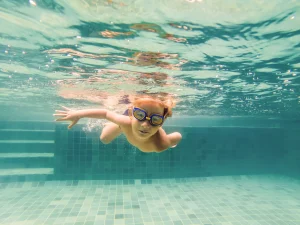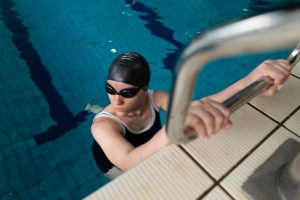Thinking about taking the plunge into swimming, but worried about the common mistakes new swimmers make? Learning to swim is both a challenging and rewarding journey. For many newcomers, whether adults or children, those first moments in the pool bring a mix of excitement and uncertainty.
While motivation is essential, real progress in swimming depends on correcting a number of recurring technical errors.
This is exactly where a qualified instructor makes all the difference in developing aquatic skills.
If this sounds like your case, explore the most common mistakes, their potential long-term impacts, and how instructors correct them to accelerate learning.
How Do Lessons Correct the Main Mistakes?
According to Swim England, around 2 million people were learning to swim in the UK in 2022. Many of them made typical mistakes – simple to resolve with proper guidance. Here are the most common:
1. Incorrect body position
One of the common mistakes new swimmers make is keeping the body poorly aligned in the water, with hips low and legs sinking. This increases drag and causes quicker fatigue.
Long-term impacts include difficulty learning other strokes, muscle strain (especially in the lower back and shoulders), and a higher risk of giving up due to early exhaustion.
Corrections in lessons involve the use of floats and balance exercises. Instructors guide the swimmer to maintain a horizontal body position, later introducing glide and breathing techniques.
Easy2Swim instructors explain that they begin with activities where the swimmer pushes off from the pool wall and focuses only on floating, avoiding abrupt movements.
2. Uncoordinated arm and leg movements
Many beginners swim with uncoordinated arms and legs, without rhythm or purpose, which hinders propulsion.
Over time, this habit leads to inefficient strokes, excessive fatigue without progress, and difficulty memorising the correct motor pattern.
Structured lessons break down the process: arms first, then legs, and only afterwards combining both. This improves coordination and rhythm.
In private lessons, instructors provide real-time corrections, adjusting angles and timing for greater cadence and fluidity.
3. Holding the breath or incorrect breathing
Breathing mistakes are among the most frequent errors: holding the breath for too long or not exhaling underwater.
This causes fatigue, discomfort, anxiety, and hinders learning more complex strokes such as front crawl or butterfly.
From the very first lessons, learners are encouraged to breathe naturally: exhaling underwater and inhaling when turning the head. Good practice includes blowing bubbles in the water and progressing to side breathing while floating.

4. Fear or tension in the water
Fear and tension often make beginners hold their body rigid, which makes floating and moving more difficult.
In the long term, this results in discouragement, emotional blocks, slower progress, and in some cases avoidance of water altogether.
The solution is to create a welcoming environment that builds confidence first. Qualified instructors work with empathy and progressive methods. Playful activities, games with floating objects, and gradual water familiarisation are essential.
According to RLSS UK, around 12.8 million Britons avoid swimming pools due to fear. Since many beginners carry childhood traumas, patience is key – starting with dipping the feet, then the head. One step at a time.
5. Lack of body awareness
A large number of beginners struggle to perceive their own position or movements in the water. This is one of the common mistakes new swimmers make, leading to incorrect execution, low precision, and frustration with the lack of progress.
Private lessons allow real-time corrections. Tools such as underwater mirrors, videos, and guided repetitions increase body awareness. Watching themselves perform helps learners assimilate technique faster and develop more accurate muscle memory.
6. Overuse of strength and lack of technique
It is common for beginners to compensate for poor technique with force. However, this results in heavy, inefficient, and tiring movements.
Over time, it may cause muscle injuries, shoulder, neck, or knee pain, slow learning, and physical exhaustion.
Lessons, on the other hand, focus on energy efficiency. Many swimmers believe that the harder they kick, the faster they will go.
But the real path is learning that rhythm, flotation, and technique are more effective than brute effort. Synchronising the glide with breathing allows the swimmer to move forward with less effort and more control.
Start Your Swimming Journey with Safety and Confidence
Making mistakes is a natural part of learning to swim. But repeating them without guidance can lead to frustration, injuries, and abandoning the activity altogether. That’s why the support of a qualified instructor is indispensable.
In addition to quickly identifying harmful habits, professionals adapt teaching to each learner’s pace and profile – always with safety, empathy, and technique.

If you or your child are just starting out in swimming, remember: challenges are part of the process, but they don’t need to be faced alone.
Easy2Swim instructors are ready to help with technique, patience, and confidence. Speak to our instructors and book your lesson today.






